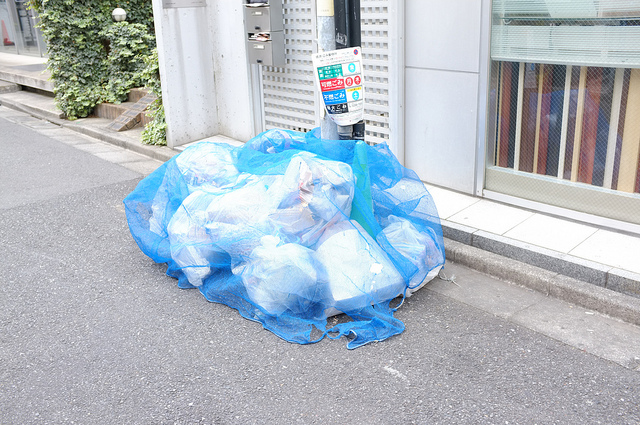
photo by Atsushi HASEGAWA
Daily rubbish and waste is something you can’t eliminate from your life. Rubbish and recycling collection may have been as simple as just putting three kinds of wheelie bins on the curbside every week in your country, but unfortunately, this doesn’t happen in Japan. There are so many rules and orders regarding rubbish sorting in Japan. In addition, such rubbish collection regulations differ depending on each area, because rubbish collections are operated by local governments. In fact, it is quite confusing for people who just started living in Japan. This column will briefly explain general ideas of rubbish and recycling collections in Japan.
About rubbish collection in Japan
In almost all areas in Japan, the waste management is operated by local governments and there is no need to make a contract with a waste collection service. On the other hand, residents must sort their rubbish according to the rules imposed by each council. Also, you may need to follow different rules when you change your address as such regulations of rubbish collections may differ city to city. The local governments normally publicly open the information about classification of household wastes and collections schedules on their website, or by brochure. Generally, rubbish collection in Japan costs very little while there are lots of rules to follow.
A majority part of household wastes are incinerated after collected by local councils and the rest is recycled, or only a small part is used for landfilling. The collection and treatments of wastes are operated by local governments, however, sorting of waste before disposal is residents’ responsibility. Also, household rubbishes must be disposed at a designated spot, for example, in front of the house, communal rubbish disposal spot of a building or area.
The following part of this column will explain actual rules of Japanese rubbish collections by using the regulations by Shinjuku council in Tokyo.
Combustible rubbish
The followings are classified as combustible rubbish. The frequency of collection differs depending on each council, however, normally it is collected twice a week. Use a container with a lid or designated rubbish bags to dispose combustible rubbish.
- Food scraps: drain off the water, sauce, soup or fluid
- Cooking oil: use oil coagulant, or absorbent material such as paper
- Paper scraps or non-recycle paper: receipts from shops, shredded paper, etc.
- Small amount of green waste: e.g. 2-3 bunches of tree branches. Large size green waste must be collected by the council by appointment (fees apply).
- Clothing, garment and disposable nappies
- Plastics: trays, containers and PET bottles with stain or dirt that cannot be cleaned, and plastic products other than trays, containers and PET bottles
- Rubbers and leathers: remove all metal parts
Plastic trays, containers and PET bottles
Plastic packaging containers such as food trays and containers are recycled. Remove all contents and rinse with tap water before disposing. Use a container with a lid or designated rubbish bags to dispose combustible rubbish.
- Plastic bags and films
- Tray and containers
- Cases and cups
- Plastic bottles other than PET bottles: PET bottles are in the same category as glass bottles and cans
- Plastic caps and lids
- Buffer materials and packaging materials
Glass bottles, cans, PET bottles and butteries
These rubbish must be separated and placed in transparent plastic bags. The frequency of collection is normally once a week.
- Glass bottles and jars: all glass bottles and jars for drinks, food, cosmetics medicines, etc.
- Cans: all aluminum or steel cans for food and drinks
- PET bottles: indicated as PET on the label. If the bottle has any stains or dirt that cannot be washed or cleaned, dispose it as combustible rubbish.
- Aerosol cans, gas cylinders and butteries: These must be used up before disposal
Metals, ceramics and other glasses
Metals wastes such as tin foils, ceramics, and other glasses such as a mirror must be placed in a container with a lid or designated rubbish bags when disposed. Wastes in this category are collected less frequently than other wastes mentioned earlier, normally twice a month. Light bulbs, hair driers and other small appliances are also included in this category.
Waste paper
Wastes such as new paper, cardboards, food and drink cartons, magazines and tissue boxes are to be disposed as waste papers. These wastes must be folded to about A4 size and tied up with a string, instead of using a container or plastic bags.
Responsible disposal
All these rules are just for disposal of general household wastes, though complicated enough to confuse new residents in Japan. Especially, if you had only two kinds of bins in your country, one for general rubbish and the other for recycles, to put on the curbside and let the waste management company deal with the rest, sorting your rubbish in Japan may be a pain in the neck. One upside of Japanese rubbish collection is that there is no need to make a contract with waste management supplier by yourself, as your local council does waste collections. Anyway, you will have to regularly sort your trash if you will live in your own house or apartment unit, or share a room with someone. It is important to know Japanese rubbish collection rules.
